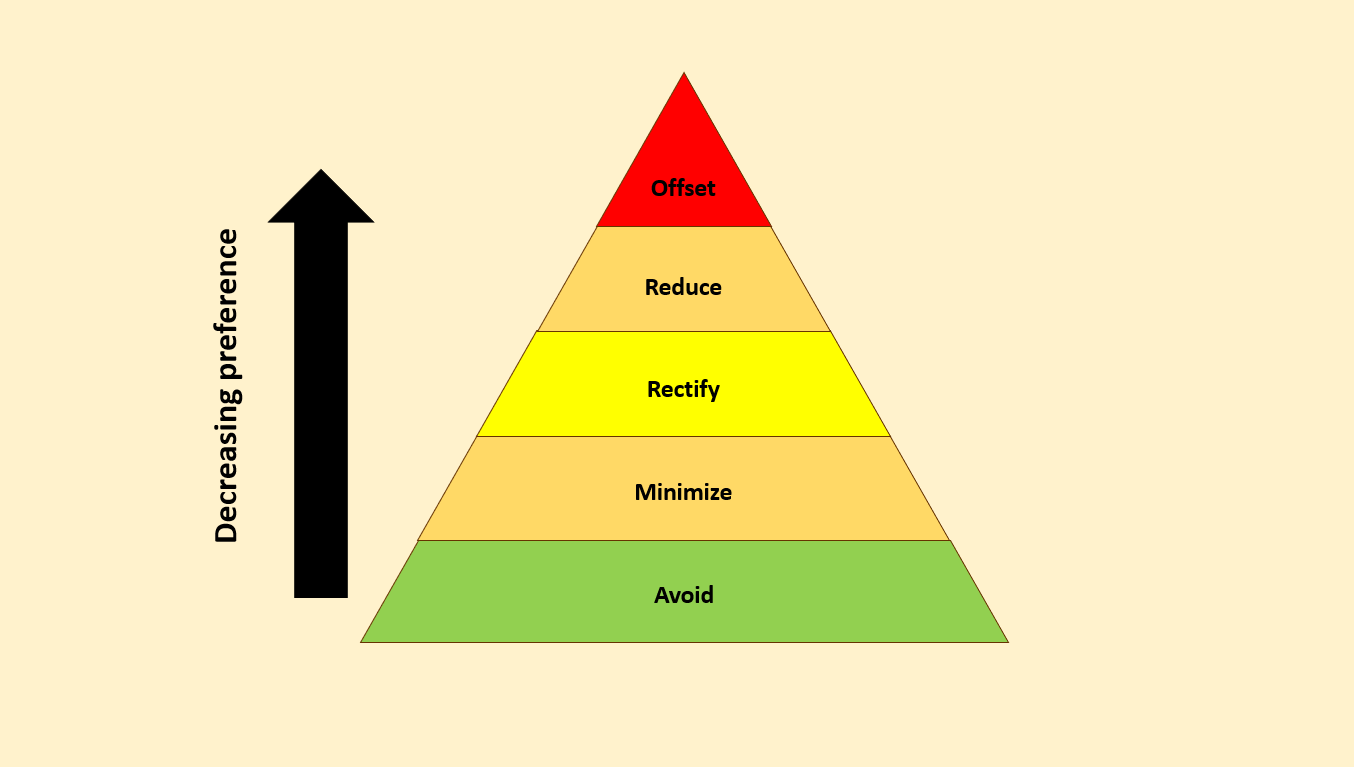Mitigation is vital to the process of EIA, because it ensures that the adverse environmental impacts of a developmental project are minimized or completely avoided. Mitigation comes with a variety of levels, and this is commonly called as “mitigation hierarchy” in EIA literature. In this post, I’ll be talking in detail about this hierarchy, and the concept of offsets in the developmental project.
Mitigation hierarchy-balancing development with natural conservation
The mitigation hierarchy consists of 5 steps that an EIA team can take to successfully mitigate environmental impacts in the project site:
- Avoid
- Minimize
- Rectify
- Reduce
- Offset
The hierarchy begins from the most beneficial method of mitigation and goes on to the least beneficial method of mitigation.

Avoidance is the first step in the mitigation hierarchy. It is the complete mitigation of an impact, by preventing it from happening. It is obviously the most preferred form of mitigation, because it ensures no environmental damage.
The second step in this hierarchy is minimize. Here, the team recognizes that the environmental impact cannot be completely side-stepped; instead, they take steps to ensure minimal damage is done to the environment.
Third, is rectify. Rectification of an impact implies that the impact has already happened; what we are doing now is damage control. In a way, rectification allows us to correct the mistake that led to the adverse environmental impact.
If rectification is not possible, we reduce the extent of the impact through management practices and/or change in our methodology. It is when even reduction is not possible that we go for the final step of the mitigation hierarchy-environmental offset.
Environmental offset is commonly defined as actions taken outside of the development site to compensate for the impacts in the development site. In effect, this means that the development authorities undertake environment conservation activities to compensate for what they do in order to achieve “no net environment loss”, or more specifically “no net biodiversity loss”.
EPA defines this as “environmentally beneficial activities undertaken to counterbalance an adverse environmental effect, aspiring to achieve “no net environment loss” or a “net environmental benefit” outcome (EPA 2006).
Since this is being done outside the development site, it is clear that the impacts on site are continuing. The boundaries of the site are dissolved and the developmental authorities are simply trying to ease their conscience or trying to appease conservationists by showing “no net environmental loss”. The beneficial work that they do may or may not even be in the same state! It need only be in the same environmental condition as the developmental project site.
Environmental offsets are a cost effective way to ensure that even though damage is being done, there is compensation for that damage. It gives more leeway for the developmental proponents to say, “Hey! We cannot do anything about the damage being caused in our site, it is unavoidable. However, we’re doing something good for the environment!”
Even within environmental offsets, there is a hierarchy that is followed. Restoration, creation, enhancement and preservation comprise this hierarchy. The last two measures concern habitats that are under severe threat of extinction/degradation.
An example
Let us consider the environmental impact of air pollution caused by release of dust particles in an industry. The first step in this hierarchy would be to take measure to completely prevent the release of dust particles. That could be by adding electrostatic precipitators in the chimneys or altering management practices or changing the chemicals being used.
If this cannot be done, the industry should look for ways to minimize the release of dust particles into the atmosphere. They could again achieve this by changing their raw materials or adding adsorbents in their chimneys.
If minimize is not an option they can consider, the next step would be to try and rectify/reduce whatever dust they do release into the atmosphere. This could be by planting trees around the industry, making the height of the chimney higher so that the dust released cannot affect live around the industry, etc.
Only if this does not work will the industry be asked to have an environmental offset project. They could sponsor conservation activities in a nearby area, or employ specialists who would work for restoration of a similar degraded site in an appropriate location.
Personally, I would much rather ensure that the developmental project avoid or minimize the impact, even if this means extra costs. However, the concept of environmental offset is gaining acceptance all over the world because it allows the project proponent to continue with their nature-destroying ways and conduct their conservation measures elsewhere.
References-
- Hayes, Nicole and Angus Morrison-Saunders, 2007. Effectiveness of environmental offsets in environmental impact assessment: practitioner perspective from Western Australia. Impact Assessment and Project Appraisal 25(3): 209-218.
- Biodiversity Offsetting

[…] https://eco-intelligent.com/2016/12/11/levels-of-mitigation-in-environmental-impact-assessment/%5B13%5D: https://blmwyomingvisual.anl.gov/mitigation%5B14%5D: […]
LikeLiked by 1 person